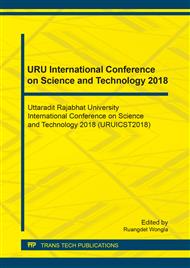[1]
H. Thatoi, B.C. Behera, R.R. Mishra, S.K. Dutta, Biodiversity and biotechnological potential of microorganisms from mangrove ecosystem: a review, Ann. Microbiol. 63(2012) 1-19.
DOI: 10.1007/s13213-012-0442-7
Google Scholar
[2]
I. Mnif, D. Ghribi, Microbial derived surface active compounds: properties and screening concept, World J. Microbiol. Biotechnol. 31 (2015) 691-706.
DOI: 10.1007/s11274-015-1866-6
Google Scholar
[3]
A. Singh, J.D.V. Hamme, O.P. Ward, Surfactants in microbiology and biotechnology: part 2. Application aspects, Biotechnol. Adv. 25(2007) 99-121.
DOI: 10.1016/j.biotechadv.2006.10.004
Google Scholar
[4]
I.M. Banat, A. Franzetti, I. Gandolfi, G. Bestetti, M.G. Martonotti, L. Fracchia, T.J. Smyth, R. Marchant, Microbial biosurfactants production, applications and future potential, Appl. Microbiol. Biotechnol. 87(2010) 427-444.
DOI: 10.1007/s00253-010-2589-0
Google Scholar
[5]
R. Marchant, I.M. Banat, Microbial biosurfactants: challenges and opportunities for future exploitation, Trends Biotechnol. 30(2012) 558-565.
DOI: 10.1016/j.tibtech.2012.07.003
Google Scholar
[6]
I.M. Banat, R.S. Makkar, S.S. Cameotra, Potential commercial applications of microbial surfactants, Appl. Microbiol. Biotechnol. 53(2000) 495-508.
DOI: 10.1007/s002530051648
Google Scholar
[7]
A. Saimmai, O. Rukadee, T. Onlamool, V. Sobhon, S. Maneerat, Characterization and phylogenetic analysis of microbial surface active compounds-producing bacteria, Appl. Biochem. Biotech. 168(2012) 1003-1018.
DOI: 10.1007/s12010-012-9836-z
Google Scholar
[8]
W.G. Weisburg, S.M. Barns, D.A. Pelletier, D.J. Lane, 16S ribosomal DNA amplification for phylogenetic study, J. Bacteriol. 173(1991) 697-703.
DOI: 10.1128/jb.173.2.697-703.1991
Google Scholar
[9]
C.C. Chooklin, S. Maneerat, A. Saimmai, Using corn husks powder as a novel substrate to produce a surface active compound from Labrenzia aggregate KP-5, J. Surf. Detergents. 21(2018) 523-539.
DOI: 10.1002/jsde.12047
Google Scholar
[10]
H.B.S. Sobrinho, R.D. Rufino, J.M. Luna, A.A. Salgueiro, G.M. Campos-Takaki, L.F.C. Leite, L.A. Sarubbo, Utilization of two agroindustrial by-products for the production of a surfactant by Candida sphaerica UCP0995, Process Biochem. 43(2008).
DOI: 10.1016/j.procbio.2008.04.013
Google Scholar
[11]
D.G. Cooper, B.G. Goldberg, Surface active agents from Bacillus species, Appl. Environ. Microbiol. 53(1987) 224-229.
DOI: 10.1128/aem.53.2.224-229.1987
Google Scholar
[12]
K. Jirasripongpun, The characterization of oil-degrading microorganisms from lubricating oil contaminated (scale) soil, Appl. Microbiol. 35(2002) 296-300.
DOI: 10.1046/j.1472-765x.2002.01184.x
Google Scholar
[13]
A. Saimmai, J. Kaewrueng, S. Maneerat, Used lubricating oil degradation and biosurfactant production by SC-9 consortia obtained from oil-contaminated soil, Ann. Microbiol. 62(2012) 1757-1767.
DOI: 10.1007/s13213-012-0434-7
Google Scholar
[14]
C.C. Lai, Y.C. Huanga, Y.H. Wei, J.S. Chang, Biosurfactant-enhanced removal of total petroleum hydrocarbons from contaminated soil, J. Hazard Mater. 167(2009): 609-614.
DOI: 10.1016/j.jhazmat.2009.01.017
Google Scholar
[15]
M.E.M. Mabrouk, E.M. Youssif, S.A. Sabry, Biosurfactant production by a newly isolated soft coral-associated marine Bacillus sp. E34: Statistical optimization and characterization, Life Sci J. 11(2014) 756-768.
Google Scholar
[16]
K. Phetrong, A. H-Kittikun, S. Maneerat, Production and characterization of bioemulsifier from a marine bacterium, Acinetobacter calcoaceticus subsp. anitratus SM7, Songklanakarin J. Sci. Technol. 29(2008) 769-779.
Google Scholar
[17]
P. Das, S. Mukherjee, R. Sen, Substrate dependent production of extracellular biosurfactant by a marine bacterium, Bioresour. Technol. 100(2008) 1015-1019.
DOI: 10.1016/j.biortech.2008.07.015
Google Scholar
[18]
L. Thimon, F. Peypoux, G. Michel, Interactions of surfactin, a biosurfactant from Bacillus subtilis with inorganic cations, Biotechnol. Lett. 14(1992) 713-718.
DOI: 10.1007/bf01021648
Google Scholar
[19]
M. Nitschke, G. Pastore, Production and properties of a surfactant obtained from Bacillus subtilis grown on cassava wastewater, Bioresour. Technol. 97(2006) 336-341.
DOI: 10.1016/j.biortech.2005.02.044
Google Scholar
[20]
O. Pornsunthorntawee, P. Wongpanit, S. Chavadej, M. Abe, R. Rujiravanit, Structural and physicochemical characterization of crude biosurfactant produced by Pseudomonas aeruginosa SP4 isolated from petroleum-contaminated soil, Bioresour. Technol. 99(2008).
DOI: 10.1016/j.biortech.2007.04.020
Google Scholar
[21]
R. S. Makkar, S. S. Cameotra, An update on the use of unconventional substrates for biosurfactant production and their new application, Appl. Microbiol. Biotechnol. 58(2002) 428-434.
DOI: 10.1007/s00253-001-0924-1
Google Scholar
[22]
M. Abouseouda, R. Maachib, A. Amranec, S. Bouderguaa, A. Nabia, Evaluation of different carbon and nitrogen sources in production of biosurfactant by Pseudomonas fluorescens, Desalination. 223(2008) 143-151.
DOI: 10.1016/j.desal.2007.01.198
Google Scholar
[23]
T.B. Lotfabad, M. Shourian, R. Roostaazad, A.R. Najafabadi, M.R. Adelzadeh, K.A. Noghabi, An efficient biosurfactant-producing bacterium Pseudomonas aeruginosa MR01, isolated from oil excavation areas in south of Iran, Colloids Surf. B. 69(2009).
DOI: 10.1016/j.colsurfb.2008.11.018
Google Scholar
[24]
A. Fiechter, Biosurfactants: moving towards industrial application, Trends Biotechnol. 10(1992) 208-217.
DOI: 10.1016/0167-7799(92)90215-h
Google Scholar
[25]
M.S. Kuyukina, I.B. Ivshina, S.O. Makarov, L.V. Litvinenko, C.J. Cunningham, J.C. Philip, Effect of biosurfactants on crude oil desorption and mobilization in a soil system, Environ. Int. 31(2005) 155-61.
DOI: 10.1016/j.envint.2004.09.009
Google Scholar


